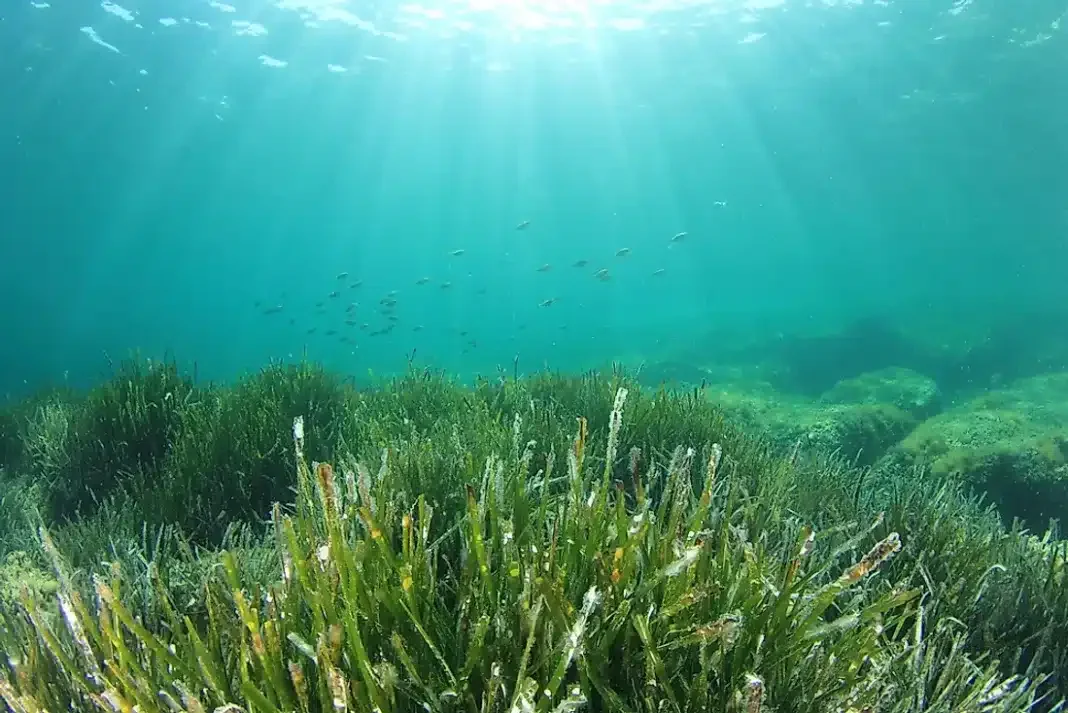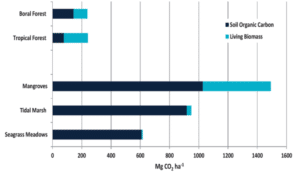Coastal ecosystems primarily the mangroves, seagrass meadows, and tidal marshes offer sustainable ecosystem services like protecting the coastal areas and nursery of marine species and offering water purification. These oceanic ecosystems and coastal areas are huge reservoirs of carbon which is termed blue carbon and the ecosystem formed by it is called Blue Carbon Ecosystem (BCE).
Blue carbon plays a crucial role in absorbing atmospheric CO2 and significantly impacts climate change and the net global distribution of carbon wealth.
Many research reports show that Australia, Indonesia, and Cuba are the largest contributors of blue-carbon net wealth to the rest of the world. However, only a few countries can entirely offset their carbon footprint through blue carbon.
In recent years, Taiwan has emerged as a pioneer in the development of a vibrant and sustainable blue carbon market. Its government is proactive in recognizing the values of blue carbon and has implemented policies and initiatives to promote its sustainable utilization.
- Taiwan’s primary focus is to enhance the carbon sequestration capacity of its coastal ecosystems and foster economic growth and ecological resilience.
- The government aims to expand its eco-conservation efforts by establishing maritime protected areas and diversifying afforestation projects.
- The sale of carbon credits generated from blue carbon projects would enable the upscaling of restoration, conservation, and development of these ecosystems
Taiwan Targets a 700K-Ton Blue Carbon Oasis by 2030.
Taiwan holds a substantial blue carbon reserve of 350,000 tons, surpassing its terrestrial forest (green carbon) counterpart. The mangrove-based blue carbon ecosystem is believed to offer a 2.5x greater carbon offsetting effect compared to a similar-sized green carbon ecosystem. This is because its geography offers a huge advantage to its vast stretch of blue carbon reserves. The island is in the western Pacific Ocean lying roughly 100 miles (160 km) off the coast of southeastern China.
Researchers and industry experts have also vouched for blue carbon as it is more resilient and stable with higher carbon sequestration and carbon sediment retention potential. Unlike forest lands that could be vulnerable to several risks like illegal deforestation and wildfires, blue carbon reserves have more endurance capacity which makes it a hotspot for investment opportunities.
Foreseeing the growth in this domain, the Taiwan government is aiming to double its current reserves to 700K tons by 2030 with intensified developmental efforts.
Figure: Comparison of potential for sequestering carbon between coastal and terrestrial forests
Source: Blue Carbon Initiative
Taiwan Opens a New Window to Blue Carbon Opportunities
Dating back to 2022, The Taiwan Ocean Union was formed with the United Nations Decade of Ocean Science for Sustainable Development (2021-2030), to foster collaboration among academic institutions, government, and other stakeholders to develop and conserve Taiwan’s marine ecosystems. The Ocean Union focuses on 5 key domains:
- blue carbon ecosystem
- marine environmental sustainability
- marine observation technology
- laws and policies for the ocean, marine databases, and research vessels
- ocean engineering technology
The chairperson of the Taiwan Ocean Union, Professor Chiang Kuoping, (also a faculty of the National Taiwan Ocean University), further fortified the Union’s objective by stating,
“The union aims at establishing a database for all sorts of marine research, providing systematic data for the experts of law and policymakers to propose effective proposals, thereby improving the government’s policy implementation. The second target is to establish and grow ocean industries.”
With this step, Taiwan is looking ahead to increase its offset methodologies for blue carbon and align with the global mission to achieve net zero by 2050.
Taiwan’s Algae Cultivation Strategy to Secure Carbon Credits
Taiwan is actively investigating the prospects of blue carbon via a pilot initiative supported by the government. One such technology is – microalgae cultivation and carbon sequestration. Given the vastness of oceans, highly efficient ocean-based carbon dioxide removal (CDR) solutions can potentially eliminate billions of tons of CO₂.
The technology involves using algae to capture carbon dioxide from its surrounding atmosphere. The algae perform photosynthesis and convert it into biomass and oxygen. The microalgae are sourced from farming, detaches, and sinks loaded with sequestered carbon.
Also, the macroalgal biomass is compressed and retained in the ocean for carbon sequestration.
For industrial applications, microalgae can generate carbon credit through multiple mechanisms. To name a few, microalgal biomass production, biofuel production, wastewater treatment, and various research and development activities related to optimizing microalgae strains and cultivation techniques.
Partnerships between the Taiwan Ocean Research Institute and National Dong Hwa University can establish a top-notch monitoring system for Taiwan’s marine species and blue carbon ecosystem.
A Greener Bliss: Blue Carbon for Carbon Credits
- Climate Mitigation: The project aligns with global climate goals by actively reducing carbon dioxide levels by incorporating ocean-based carbon dioxide removal technologies.
- Renewable Energy Source: Microalgae-derived biofuels provide a sustainable and renewable energy source, reducing dependence on fossil fuels and contributing to a cleaner energy landscape.
- Environmental Stewardship: Taiwan’s initiative underscores its commitment to environmental stewardship, demonstrating responsible and innovative approaches to address climate challenges.
As per reports, Taiwan’s Ocean Affairs Council has finalized the revision of the “Blue Carbon Methodology” for native mangroves and seagrass beds. This initiative, currently under review by the Ministry of Environment, aims to “standardize measurement procedures for blue carbon sequestration and greenhouse gas reduction.”
In March 2022, Taiwan officially published “Taiwan’s Pathway to Net-Zero Emissions in 2050”, which provides the action plan to achieve 2050 Net-Zero Emissions and develop its blue carbon.
From this analysis, we can conclude that Taiwan’s blue carbon reserve initiative towards achieving the ambitious target of 700 K-ton by 2030 has considerable ground to cover.


